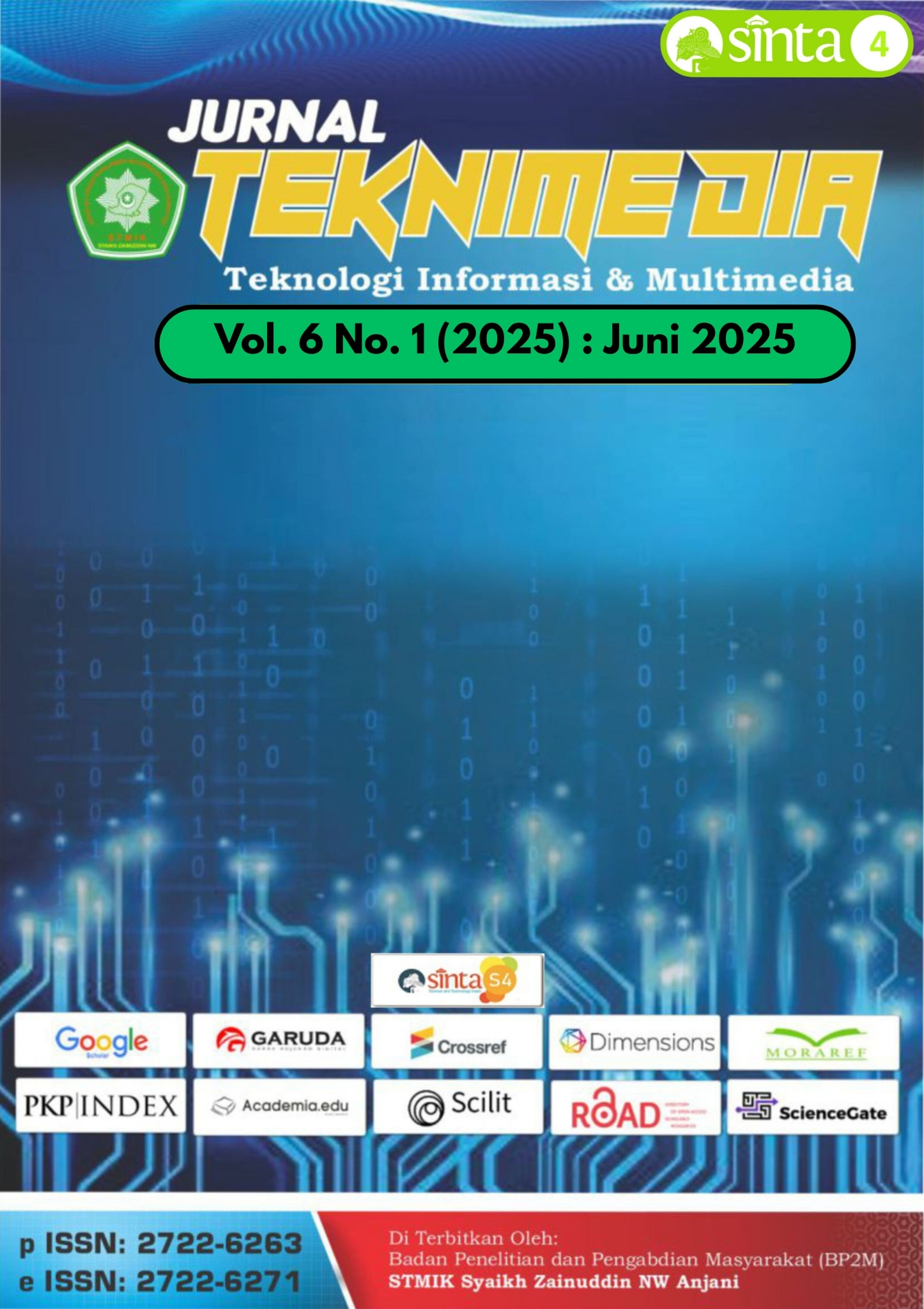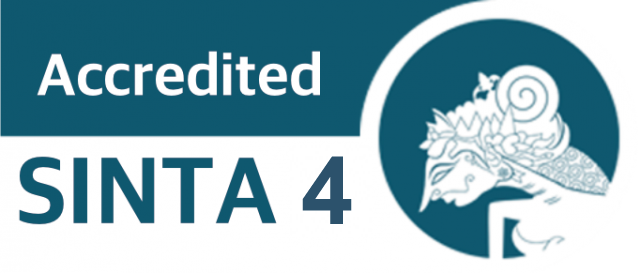VIRTUAL TOUR BERBASIS E-PANORAMA SEBAGAI PENGENALAN KAMPUS UNIVERSITAS PENDIDIKAN MANDALIKA
Abstract
The rapid development of information technology has encouraged the emergence of digital innovations in various fields, one of which is Virtual Tour innovation. Undikma campus needs to have a visual promotional media that can describe the campus facilities and environment as a whole, and is easily accessible to prospective students and the wider community. Based on these problems, this research aims to build an E-Panorama-based Virtual Tour as a medium for introducing Undikma campus visually to prospective students and the public through a website that can be accessed by anyone. By utilizing 360-degree panoramic photos, this Virtual Tour is expected to provide an interactive visual experience for users and increase the attractiveness of Undikma campus for prospective students and the community. The development model used in this research is the Multimedia Development Life Cycle (MDLC), which consists of six stages, namely concept, design, material collecting, assembly, testing, and distribution. Based on the results of the feasibility test, it shows that the Virtual Tour meets high standards with a feasibility percentage of 87 percent from media experts and 85.72 percent from users, so that this Virtual Tour can be declared suitable for use with a very good level of acceptance. So, it can be concluded from this research that the construction of the E-Panorama-based Virtual Tour has succeeded in achieving its goal as a medium for visually introducing the Undikma campus to prospective students and the public through a website that can be accessed by anyone and can be well received by users.
References
[2] M. N. Raihan and I. G. L. P. Eka Prismana, “Implementasi Sistem Virtual Tour E-Panorama Sebagai Media Informasi dan Pengenalan Gedung Jurusan Teknik Informatika Universitas Negeri Surabaya,” J. Informatics Comput. Sci., vol. 5, no. 03, pp. 291–303, 2023, doi: 10.26740/jinacs.v5n03.p291-303.
[3] Z. Muttaqin, T. Nurhadiyan, and Y. Arifin, “Aplikasi Virtual Tour Tempat Wisata Alam Gunung Pilar Di Kabupaten Serang,” ProTekInfo(Pengembangan Ris. dan Obs. Tek. Inform., vol. 8, no. 1, pp. 1–6, 2021, doi: 10.30656/protekinfo.v8i1.5056.
[4] T. L. M. Suryanto, N. C. Wibowo, A. P. Wibawa, and B. Nadhiroh, “Analisis Penerapan Aplikasi Museum Virtual Indonesia (Simvoni),” J. Sist. Inf. dan Bisnis Cerdas, vol. 15, no. 1, pp. 49–54, 2022, doi: 10.33005/sibc.v15i1.8.
[5] S. Riyadi, I. Nurhaida, U. Mercubuana, P. Korespondensi, and U. M. Buana, “Aplikasi Sistem Virtual Tour E-Panorama 360 Derajat Virtual Tour E-Panorma 360 Degree System Application Based on Android for Introduction Mercu Buana Campus,” J. Teknol. Inf. dan Ilmu Komput., vol. 9, no. 1, pp. 17–24, 2022, doi: 10.25126/jtiik.202294209.
[6] D. Dio, N. Safriadi, and A. S. Sukamto, “Rancang Bangun Aplikasi Virtual Tour Lokasi Rekreasi dan Hiburan Keluarga di Pontianak,” J. Sist. dan Teknol. Inf., vol. 7, no. 1, p. 1, 2019, doi: 10.26418/justin.v7i1.27384.
[7] I. G. B. Subawa, I. N. E. Mertayasa, and D. S. Wahyuni, “Pengembangan Virtual Tour Program Studi Pendidikan Teknik Informatika Berbasis Fotografi 360 Derajat,” Kumpul. Artik. Mhs. Pendidik. Tek. Inform., vol. 11, no. 3, pp. 334–343, 2022.
[8] A. Fauzan, Z. Maisat Eka, Z. Fairozal Akbar, and K. Fathoni, “Pengembangan Aplikasi Virtual Tour sebagai Media Pengenalan Lingkungan Kampus PENS berbasis Website,” J. Teknol. Terpadu, vol. 7, no. 1, pp. 23–30, 2021, doi: 10.54914/jtt.v7i1.341.
[9] A. B. Virtual Tour Daerah Konservasi Sumber Daya Alam di Sulawesi Utara Corneles Ulukyanan, B. S. Narasiang, and B. A. Sugiarso, “Virtual Tour of Natural Resources Conservation Area in North Sulawesi,” J. Tek. Inform., vol. 16, no. 2, p. 203, 2021.
[10] F. Alfiansyah, S. Lina, and M. Sitio, “Implementasi Metode Multimedia Development Life Cycle (Mdlc) Pada Aplikasi Edukasi Interaktif Pengenalan Mental Health Kepada Masyarakat Berbasis Mobile,” Log. J. Ilmu Komput. dan Pendidik., vol. 1, no. 1, pp. 6–16, 2022, [Online]. Available: https://journal.mediapublikasi.id/index.php/logic
[11] Y. Sumaryana and M. Hikmatyar, “Aplikasi Pembelajaran Siswa Sekolah Dasar Menggunakan Metode Multimedia Development Life Cycle (Mdlc),” TeIKa, vol. 10, no. 2, pp. 117–124, 2020, doi: 10.36342/teika.v10i2.2381.
[12] R. Rosmiati, B. P. Nugroho, S. Hendartie, S. Sulistyowati, and R. Rudini, “Media Informasi Peraga Alat Fitness Berbasis Multimedia,” J. Sains Komput. dan Teknol. Inf., vol. 4, no. 2, pp. 17–21, 2022, doi: 10.33084/jsakti.v4i2.3360.
[13] D. G. Thomas, S. R. U. A. Sompie, and B. A. Sugiarso, “Virtual Tour Sebagai Media Promosi Interaktif Penginapan Di Kepulauan Bunaken,” J. Tek. Inform., vol. 13, no. 1, pp. 14–22, 2018, doi: 10.35793/jti.13.1.2018.20188.
[14] E. L. Hady, K. Haryono, and N. W. Rahayu, “User Acceptance Testing (UAT) pada Purwarupa Sistem Tabungan Santri (Studi Kasus: Pondok Pesantren Al-Mawaddah),” J. Ilm. Multimed. dan Komun., vol. 5, no. 1, pp. 1–10, 2020.
[15] D. Satrio and A. Muhardono, “Virtual Tour Berbasis Website Sebagai Pendukung Media Pemasaran Kampus,” J. Minfo Polgan, vol. 12, no. 1, pp. 289–296, 2023, doi: 10.33395/jmp.v12i1.12372.
Copyright (c) 2025 TEKNIMEDIA: Teknologi Informasi dan Multimedia

This work is licensed under a Creative Commons Attribution-ShareAlike 4.0 International License.
Semua tulisan pada jurnal ini menjadi tanggungjawab penuh penulis. Jurnal Teknimedia memberikan akses terbuka terhadap siapapun agar informasi dan temuan pada artikel tersebut bermanfaat bagi semua orang. Jurnal Teknimedia dapat diakses dan diunduh secara gratis, tanpa dipungut biaya, sesuai dengan lisensi creative commons yang digunakan.

Jurnal TEKNIMEDIA : Teknologi Informasi dan Multimedia is licensed under a Lisensi Creative Commons Atribusi-BerbagiSerupa 4.0 Internasional


.png)





